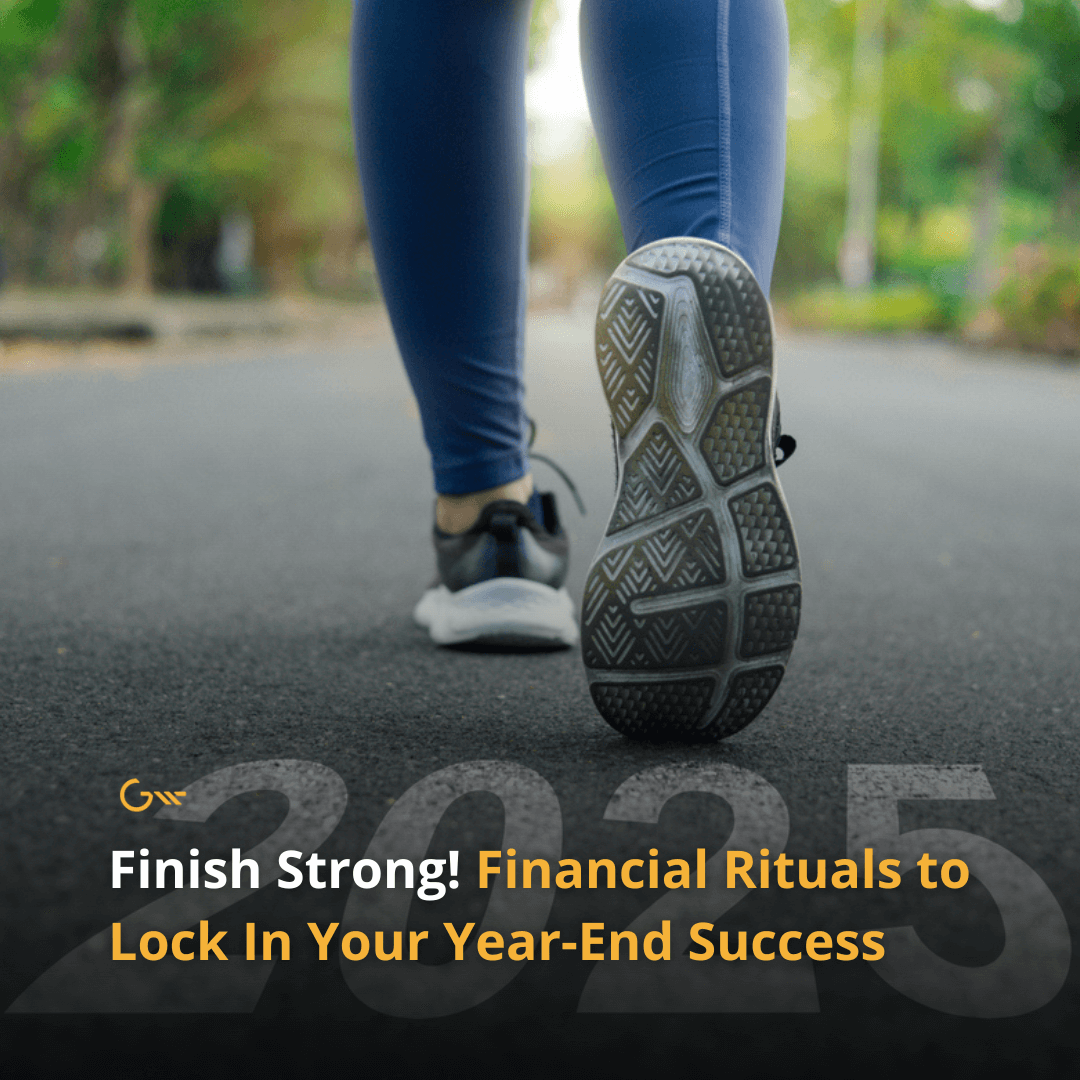What if finishing this year strong matters more than how you start the next one?
Most people dream about fresh starts in January—new goals, clean slates, bold resolutions. But here’s what we’ve learned after decades of guiding families through life’s key moments: the professionals who finish each year with intention consistently outpace those who wait for January to course-correct.
The difference isn’t luck. It’s ritual.
The Marathon Runner’s Secret
Elite marathon runners know something counterintuitive: the last mile determines everything. It’s not about starting strong or maintaining pace through the middle miles. It’s about how you finish.
Around mile 20, when glycogen stores deplete and every step feels heavy, champions don’t just push harder—they execute a practiced ritual. They’ve trained their bodies and minds to recognize this moment and respond with precision: adjust their breathing, recalibrate their stride, visualize the finish line, and draw on reserves they’ve carefully built.
Your financial life works the same way. As the year winds down and life feels overwhelming, the families who thrive don’t simply power through—they pause and execute their own year-end ritual.
Chris and Emily’s Wake-Up Call
That’s exactly where Chris and Emily found themselves last November. Both 47, they were accomplished professionals juggling demanding careers while their three kids navigated major transitions—one in college, one a high school senior facing application deadlines, and their oldest recently independent but still learning to manage finances.
“We kept saying we’d ‘get to it,'” Emily remembers. “But between work deadlines, college visits, and helping my parents downsize, November arrived and we realized we’d made zero progress on year-end planning.”
When they finally carved out a Saturday morning to review their finances, the picture was uncomfortable. They had multiple old 401(k) accounts gathering dust. Their cash reserves were depleted from unexpected home repairs. Their estate documents still listed their parents as guardians—despite having adult children. And they’d missed opportunities for tax-advantaged giving despite wanting to support causes they cared about.
“I felt behind,” Chris admitted. “Like we’d been working incredibly hard but moving sideways instead of forward.”
Sound familiar?
The Power of Year-End Financial Rituals
In times like these, what you need isn’t more complexity—it’s clarity through intentional action.
At Gatewood, we encourage families to develop financial rituals—purposeful habits that help you pause, reflect, and make decisions aligned with your values before the year closes. Think of these as your financial equivalent of the marathon runner’s final-mile strategy: practiced moves that help you finish strong when it matters most.
Even Benjamin Franklin, known for his disciplined routines, would end each day asking: “What good have I done today?” The same principle applies at year-end. A few thoughtful financial actions in November and December create momentum that carries into the new year.
Here are six essential year-end rituals that can help you finish strong and enter 2026 with confidence.
1. Take Inventory of Your Financial Life
You can’t improve what you can’t see clearly.
Start by gathering a complete picture: recent bank statements, retirement and investment accounts, outstanding debts, insurance policies. Review your cash flow—not just what you earn, but where it actually goes and what remains.
This isn’t about judgment. It’s about awareness—the foundation of purposeful decision-making.
Gatewood Insight: We find that families who maintain real-time visibility into their complete financial picture make better decisions during life’s key moments. Our integrated technology gives you this clarity continuously, not just once a year.
2. Review Your Tax Picture Before December 31
Most people think about taxes in April, when opportunities have passed. A year-end tax review gives you time to act strategically.
Consider:
- Are you maximizing retirement contributions (401(k), IRA, HSA)?
- Would converting part of a traditional IRA to a Roth make sense given your current income?
- Can you harvest investment losses to offset gains?
- Are there charitable contributions you planned but haven’t executed?
A proactive conversation with your wealth advisor before year-end often saves thousands—and eliminates April stress.
Gatewood Insight: Tax efficiency isn’t just about this year’s return—it’s about positioning your wealth for decades. Our CFP® Wealth Planners integrate tax strategy into your comprehensive plan, identifying opportunities others miss.
3. Align Your Investments with Your Goals
Markets change. So do your goals, risk tolerance, and time horizon.
If you’re in your 40s or 50s, you may need to recalibrate—ensuring you’re taking appropriate risk for long-term growth without exposing yourself unnecessarily during your peak earning years.
A thoughtful rebalancing now helps preserve what you’ve earned while positioning you for what’s ahead.
Gatewood Insight: Unlike firms that outsource investment management, our in-house Investment Committee makes decisions with your specific goals in mind. You have direct access to the people managing your wealth—because this is your money, and you deserve to understand every decision we make on your behalf.
4. Strengthen Your Safety Net
Unexpected expenses derail even the strongest financial plans. Review your cash reserves honestly: do you have enough set aside to cover several months of expenses, a major home repair, or a child’s emergency?
This cushion isn’t just for crises—it’s what keeps you from selling investments during market downturns or accumulating high-interest debt when life happens.
Gatewood Insight: One of the biggest mistakes we see is families over-investing, leaving insufficient cash reserves. Our dynamic planning approach maintains strategic cash buffers that adjust with market conditions and your life stage—preserving cash during the next inevitable downturn.
5. Update Your Legacy and Protection Plan
Life moves quickly. Estate documents that made sense five years ago may no longer reflect your current reality.
Make sure your beneficiaries, wills, and powers of attorney align with your family’s current situation. If your children are now adults, update documents accordingly. Review your life and disability insurance—does coverage still match your income, obligations, and family needs?
These updates take an afternoon but can make a generational difference.
Gatewood Insight: Estate planning isn’t a one-time event—it’s an ongoing element of building enduring wealth with purpose. Our dedicated Client Care Teams seek to ensure that these critical details don’t fall through the cracks as your life evolves.
6. Reconnect With Your Purpose
The end of the year is a natural time for reflection. What truly mattered this year—family milestones, community involvement, the impact you’re making?
If charitable giving aligns with your values, consider tax-efficient strategies like donating appreciated stock or establishing a donor-advised fund.
This is where financial planning transcends numbers. When your wealth serves your deeper purpose, money transforms from a source of stress into a tool for meaning and legacy.
Gatewood Insight: We believe wealth is personal. Our process isn’t about products or generic solutions—it’s about understanding your “why” and building a plan that makes an impact on both your life and your legacy.
Chris and Emily’s Turnaround
After working through these year-end rituals with their Gatewood Client Care team, Chris and Emily’s perspective shifted dramatically.
In one focused afternoon, they:
- Consolidated three old 401(k)s, reducing fees and simplifying oversight
- Increased their savings rate by 3% after reviewing their cash flow
- Established a 529 plan for their youngest with automatic monthly contributions
- Rebuilt their cash reserves to six months of expenses
- Updated all estate documents and beneficiary designations
- Donated appreciated stock to their favorite charity, maximizing both impact and tax benefits
“We went from feeling scattered and behind to feeling focused and in control,” Emily shared. “For the first time in years, our finances matched the purpose we’d been working toward all along. We didn’t just finish the year—we finished it strong.”
The difference? They stopped treating year-end planning as a chore and started treating it as a ritual—a purposeful practice aligned with building enduring wealth with confidence.
Your Turn to Finish Strong
As the calendar turns, most people set new goals for the year ahead. But the most successful families we serve do something different: they finish the current year intentionally, closing the books on what matters most before rushing into what’s next.
At Gatewood, we believe year-end planning isn’t about adding stress—it’s about creating clarity and confidence. Through our Firm-to-FamilyTM model, your dedicated Client Care Team—including your Wealth Advisor, CFP® Wealth Planner, and Wealth Coordinator—seeks to ensure nothing falls through the cracks during life’s busiest seasons.
We’re process-driven, not product-driven. We’re relationship-focused, not transaction-focused. And we’re committed to independence, which means your interests always come first—this year, next year, and for decades to come.
Don’t let another year slip by on autopilot.
The decisions you make in November and December create the foundation for next year’s success. Whether you’re navigating career transitions, preparing for retirement, managing family complexity, or simply want to ensure you’re making the most of your hard work—we’re here to guide you through life’s key moments with expertise and care.
Take time to finish strong. The confidence you’ll feel entering 2026 is worth far more than any New Year’s resolution.
Ready to begin your year-end review?
Schedule a conversation with Gatewood Wealth Solutions. Let’s talk about finishing this year with purpose—and building the confidence you deserve for all of life’s key moments ahead.
Important Disclosures:
The opinions voiced in this material are for general information only and are not intended to provide specific advice or recommendations for any individual.
Investing involves risk including loss of principal. No strategy assures success or protects against loss.
Rebalancing a portfolio may cause investors to incur tax liabilities and/or transaction costs and does not assure a profit or protect against a loss.
This information is not intended to be a substitute for specific individualized tax or legal advice. We suggest that you discuss your specific situation with a qualified tax or legal advisor.
This is a hypothetical example and is not representative of any specific situation. Your results will vary.
A plan participant leaving an employer typically has four options (and may engage in a combination of these options), each choice offering advantages and disadvantages:
- Leave the money in his/her former employer’s plan, if permitted;
- Roll over the assets to his/her new employer’s plan, if one is available and rollovers are permitted;
- Roll over to an IRA; or
- Cash out the account value





